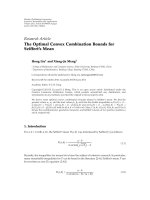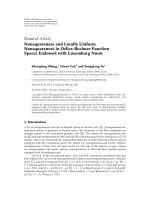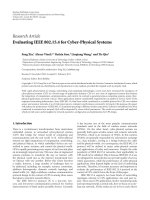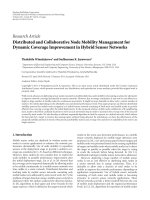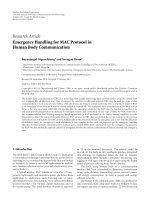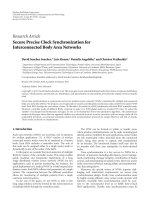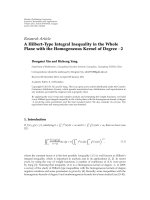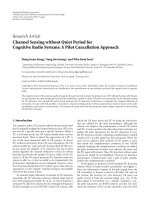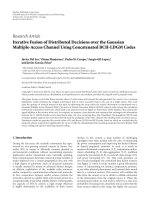Báo cáo hóa học: "Research Article Distributed Fusion Receding Horizon Filtering in Linear Stochastic Systems" doc
Bạn đang xem bản rút gọn của tài liệu. Xem và tải ngay bản đầy đủ của tài liệu tại đây (761.51 KB, 8 trang )
Hindawi Publishing Corporation
EURASIP Journal on Advances in Signal Processing
Volume 2009, Article ID 929535, 8 pages
doi:10.1155/2009/929535
Research Article
Distributed Fusion Receding Horizon Filtering in
Linear Stochastic Systems
Il Young Song,
1
Du Yong Kim,
1
Yo n g Hoon Kim,
1
Suk Jae Lee,
2
and Vladimir Shin
1
1
School of Information and Mechatronics, Gwangju Institute of Sc ience and Technology, 1 Oryong-Dong, Buk-Gu,
Gwangju 500-712, South Korea
2
Agency for Defense Development (ADD), Jochiwongil 462, Yuseong, Daejeon 305-152, South Korea
Correspondence should be addressed to Vladimir Shin,
Received 5 May 2009; Accepted 21 September 2009
Recommended by Fredrik Gustafsson
This paper presents a distributed receding horizon filtering algorithm for multisensor continuous-time linear stochastic systems.
Distributed fusion with a weighted sum structure is applied to local receding horizon Kalman filters having different horizon
lengths. The fusion estimate of the state of a dynamic system represents the optimal linear fusion by weighting matrices under
the minimum mean square error criterion. The key contribution of this paper lies in the derivation of the differential equations
for determining the error cross-covariances between the local receding horizon Kalman filters. The subsequent application of the
proposed distributed filter to a linear dynamic system within a multisensor environment demonstrates its effectiveness.
Copyright © 2009 Il Young Song et al. This is an open access article distributed under the Creative Commons Attribution License,
which permits unrestricted use, distribution, and reproduction in any medium, provided the original work is properly cited.
1. Introduction
The concept of multisensor data fusion is the combination
of data generated by a number of sensors in order to obtain
more valuable data and perform inferences that may not be
possible from a single sensor alone. This process has attracted
growing interest for its potential applications in areas such as
robotics, aerospace, and environmental monitoring, among
others [1, 2].
In general, there are two fusion estimation methods
commonly used to process the measured sensor data [3, 4].
If a central processor directly receives the measurement data
of all local sensors and processes them in real time, the
correlative result is known as the centralized estimation.
However, this approach has some serious disadvantages,
including bad reliability and survivability, as well as heavy
communication and computational burdens.
The second method is called distributed estimation
fusion, in which every local sensor is attached to a local
processor. In this method, the processor optimally estimates
a parameter or state of a system based on its own local
measurements and transmits its local estimate to the fusion
center where the received information is suitably associated
to yield the global inference. The advantage of this approach
is that the parallel structures would cause enlarge the input
data rates and make easy fault detection and isolation
[1–5]. Recently, various distributed and parallel versions
of standard Kalman filters have been reported for linear
dynamic systems within a multisensor environment [6–10].
To achieve a robust and accurate estimate of the state of a
system under potential uncertainty, various techniques have
been previously introduced and discussed. Among them,
the receding horizon technique is popular and successful,
due to its robustness against temporal uncertainty, and has
been rigorously investigated. The receding horizon strategy
was first introduced by Jazwinski, who labeled it as limited
memory filtering [11]. The dynamic system without the
process noise is believed to describe the efficiency of the idea
through the maximum likelihood estimation scheme [11].
Following this, the optimal FIR filter for time-varying state-
space models was suggested by W. H. Kwon et al. [12]. FIR
filters make use of finite input and output measurements on
the most recent time interval, called the receding horizon, or
a horizon which is a moving, fixed-size estimation window.
Because of the complicated structure of the FIR filter, a
modified receding horizon Kalman FIR filter for linear
continuous-time systems was proposed in [13]. As a general
rule, the local receding horizon Kalman filters (LRHKFs) are
2 EURASIP Journal on Advances in Signal Processing
typically more robust against dynamic model uncertainties
and numerical errors than standard local Kalman filters,
whichutilizeallmeasurements[14–17].
Distributed receding horizon fusion filtering for multiple
sensors with equal horizon time intervals (horizon lengths)
has also been proposed in [16]. In this case, all LRHKFs with
the same horizon time interval, which are fused, utilize finite
measurements over the most recent time interval [12–16].
In this paper, we consider the generalization of [16]for
arbitrary, nonequal horizon lengths. Design of distributed
filters for sensor measurements with nonequal horizon
lengths is generally more complicated than for equal lengths
due to a lack of common time intervals that contain all sensor
data, making it impossible to design a centralized filtering
algorithm. We propose using a distributed receding horizon
filter for a set of local sensors with nonequal horizon lengths.
Also, we derive the key differential equations for error
cross-covariances between LRHKFs using different horizon
lengths.
The remainder of this paper is organized as follows. The
problem setting is described in Section 2.InSection 3,we
present the main results pertaining to the distributed reced-
ing horizon filtering for a multisensor environment. Here,
the key equations for cross-covariances between the local
receding horizon filtering errors are derived. In Section 4,
two examples for continuous-time dynamic systems within
a multisensor environment illustrate the main results, and
concluding remarks are then given in Section 5.
2. Problem Setting
Consider the linear continuous-time dynamic system with N
sensors:
˙
x
t
= F
t
x
t
+ G
t
v
t
, x
0
= x
t
0
, t ≥ t
0
,(1)
y
(i)
t
= H
(i)
t
x
t
+ w
(i)
t
, i = 1, ,N,(2)
where x
t
∈ R
n
is the state, y
(i)
t
∈ R
m
i
is the measurement,
the system noise v
t
∈ R
r
and the measurement noises
w
(i)
t
∈ R
m
i
, i = 1, , N are uncorrelated white Gaussian
noises with zero mean and intensity matrices Q
t
and
R
(i)
t
,respectively,andF
t
, G
t
,andH
(i)
t
are matrices with
compatible dimensions. Also, the superscript (i) denotes the
ith sensor, and N is the total number of sensors.
The initial state x
0
∼ N(m
0
; P
0
), m
0
= E(x
0
), P
0
=
cov{x
0
, x
0
} is assumed to be Gaussian and uncorrelated with
v
t
and w
(i)
t
, i = 1, ,N.
Our purpose, then, is to find the distributed fusion
estimate of the state x
t
based on the overall horizon sensor
measurements Y
t
with different horizon time intervals Δ
i
,
i
= 1, , N, such that
Y
t
=
Y
(1)
t
, , Y
(N)
t
,
Y
(i)
t
=
y
(i)
s
: t − Δ
i
≤ s ≤ t
, i = 1, ,N
.
(3)
3. Distributed Fusion Receding Horizon Filter
Now, we will show that the fusion formula (FF) [10, 17]
is able to serve as the basis for designing a distributed
fusion filter. A new distributed fusion receding horizon filte r
with nonequal horizon lengths (NE-DFRHF) includes two
stages. In the first stage, LRHKFs (estimates)
x
(1)
t
, , x
(N)
t
are
computed and then linearly fused at the second stage based
on the FF.
Firststep(CalculationofLRHKFs). According to (1)and(2),
we have N local dynamic subsystems with the state vector x
t
and local (individual) sensor measurement y
(i)
t
:
˙
x
t
= F
t
x
t
+ G
t
v
t
, x
0
= x
t
0
,
y
(i)
t
= H
(i)
t
x
t
+ w
(i)
t
,
(4)
where the number i of a local subsystem is fixed.
Next, let us denote the local receding horizon estimate
of the state x
t
based on the individual sensor measurements
Y
(i)
t
={y
(i)
s
: t − Δ
i
≤ s ≤ t} by x
(i)
t
. To determine x
(i)
t
we can apply the optimal receding horizon Kalman filter to
subsystem (4)[12–15] to obtain the following differential
equations:
˙
x
(
i
)
s
= F
s
x
(
i
)
s
+ K
(i)
s
y
(i)
s
−H
(i)
s
x
(
i
)
s
,
˙
P
(
ii
)
s
= F
s
P
(ii)
s
+ P
(ii)
s
F
T
s
−P
(ii)
s
H
(
i
)
T
s
R
(
i
)
−1
s
H
(
i
)
s
P
(
ii
)
s
+
Q
s
,
K
(i)
s
= P
(ii)
s
H
(
i
)
T
s
R
(
i
)
−1
s
,
Q
s
= G
s
Q
s
G
T
s
,
P
(ii)
s
= cov
e
(
i
)
s
, e
(
i
)
s
, e
(
i
)
s
= x
s
− x
(
i
)
s
,
t
−Δ
i
≤ s ≤ t, i = 1, , N
(5)
with the horizon initial conditions:
x
(i)
s
=t−Δ
i
= m
t−Δ
i
= E
x
t−Δ
i
,
P
(ii)
s
=t−Δ
i
= P
t−Δ
i
= cov
x
t−Δ
i
, x
t−Δ
i
(6)
determined by the Lyapunov equations [15] on the interval
τ
∈ [t
0
, t −Δ
i
]:
˙
m
τ
= F
τ
m
τ
, t
0
≤ τ ≤ t −Δ
i
, m
t
0
= m
0
,
˙
P
τ
= F
τ
P
τ
+ P
τ
F
T
τ
+
Q
τ
, P
t
0
= P
0
.
(7)
Thus, we obtain the N LRHKFs
x
(1)
t
, , x
(N)
t
with the
corresponding local error covariances P
(11)
t
, , P
(NN)
t
.
Second step (Fusion of LRHKFs). To express the final NE-
DFRHF (estimate)
x
fus
t
for the state x
t
in terms of the
LRHKFs
x
(1)
t
, , x
(N)
t
, we use the FF. In this case,
x
fus
t
=
N
i=1
c
(i)
t
x
(i)
t
,
N
i=1
c
(i)
t
= I
n
,
(8)
where I
n
is the identity matrix, and c
(1)
t
, , c
(N)
t
are the time-
varying weighted matrices determined by the mean square
criterion.
EURASIP Journal on Advances in Signal Processing 3
Theorem 1 (see [10, 17]). (a) The optimal weights c
(1)
t
, ,
c
(N)
t
satisfy the following linear algebraic equations:
N
i=1
c
(i)
t
P
(ij)
t
−P
(iN)
t
=
0,
N
i=1
c
(i)
t
= I
n
, j = 1, , N − 1
,
(9)
and they can be explicitly written in the following form:
c
(i)
t
=
N
j=1
W
(ij)
t
⎛
⎝
N
l,h=1
W
(lh)
t
⎞
⎠
−1
, i = 1, ,N, (10)
where W
(ij)
t
is the (ij)th (n × n) submatrix of the (nN ×nN)
block matrix P
−1
t
, P
t
= [P
(ij)
t
]
N
i,j
=1
.
(b) The fusion error covariance P
fus
t
= cov{e
fus
t
, e
fus
t
},
e
fus
t
= x
t
− x
fus
t
is given by
P
fus
t
=
N
i,j=1
c
(i)
t
P
(ij)
t
c
(j)
T
t
. (11)
Therefore, (9)–(11), defining the unknown weights c
(i)
t
and
fusion error covariance P
fus
t
, depend on the local covariances
P
(ii)
t
,determinedby(5), and the local cross-covariances
P
(ij)
t
= cov
e
(i)
t
, e
(j)
t
, i, j = 1, , N, i
/
= j
,
(12)
given in Theorem 2.
Theorem 2. Without losing generality, let one assume that
Δ
i
< Δ
j
or t − Δ
i
>t− Δ
j
. (a) The local cross-covariances
(12) satisfy the following differential equations:
˙
P
(ij)
s
=
F
(i)
s
P
(ij)
s
+ P
(ij)
s
F
(j)
T
s
+ Q
s
, s ∈
[
t
−Δ
i
, t
]
,
F
(i)
s
= F
s
−K
(i)
s
H
(i)
s
, i, j = 1, , N, i
/
= j
(13)
with the horizon initial conditions:
P
(ij)
s
=t−Δ
i
(6)
= P
t−Δ
i
−cov
x
t−Δ
i
, x
(j)
t
−Δ
i
.
(14)
(b) The covariance cov
{x
t−Δ
i
, x
(j)
t
−Δ
i
} in (14) represents the
nondiagonal element of the block covariance-matrix D
(j)
τ
:
D
(j)
τ
=
⎡
⎢
⎣
cov{x
τ
, x
τ
} cov
x
τ
, x
(j)
τ
cov
x
(j)
τ
, x
τ
cov
x
(j)
τ
, x
(j)
τ
⎤
⎥
⎦
(15)
at τ
= t −Δ
i
, descr ibed by the Lyapunov equation:
˙
D
(j)
τ
= A
(j)
τ
D
(j)
τ
+ D
(j)
τ
A
(j)
T
τ
+ B
(j)
τ
Q
(j)
τ
B
(j)
T
τ
,
A
(j)
τ
=
⎡
⎣
F
τ
0
K
(j)
τ
H
(j)
τ
F
(j)
τ
⎤
⎦
, B
(j)
τ
=
⎡
⎣
G
τ
0
0 K
(j)
τ
⎤
⎦
,
Q
(j)
τ
=
⎡
⎣
Q
τ
0
0 R
(j)
τ
⎤
⎦
, τ ∈
t −Δ
j
; t −Δ
i
(16)
w ith the initial condition:
D
(j)
τ
=t−Δ
j
=
⎡
⎣
cov
x
t−Δ
j
, x
t−Δ
j
0
00
⎤
⎦
=
⎡
⎣
P
t−Δ
j
0
00
⎤
⎦
,
(17)
determined by (7).
The derivations of (13)–(17) are given in the appendix.
Thus, (5)–(17) completely define NE-DFRHF.
In the particular case of equal horizon lengths (Δ
i
= Δ,
i
= 1, , N), the local cross-covariances (12) satisfy the
following differential equations:
˙
P
(ij)
s
=
F
(i)
s
P
(ij)
s
+ P
(ij)
s
F
(j)
T
s
+
Q
s
, t −Δ ≤ s ≤ t,
F
(i)
s
= F
s
−K
(i)
s
H
(i)
s
, i, j = 1, , N, i
/
= j
(18)
with the horizon initial conditions P
(ij)
t
−Δ
= P
t−Δ
and gains
K
(i)
s
determined by (5)–(7), respectively.
Remark 3. The LRHKFs
x
(i)
t
, i = 1, , N can be separated
for different types of sensors. In other words, each local
estimate
x
(i)
t
can be found independently of the other esti-
mates. Therefore, LRHKFs can be implemented in parallel
for different sensors (2).
Remark 4. Note, however, that the local error covariances
P
(ij)
t
, i, j = 1, N and the weights c
(i)
t
may be precomputed,
since they do not depend on the sensor measurements
(3), but rather on the noise statistics Q
t
and R
(i)
t
and the
system matrices F
t
, G
t
,andH
(i)
t
, which are the part of
the system model (1), (2). Thus, once the measurement
schedule has been settled, the real-time implementation of
NE-DFRHF requires only the computation of the LRHKFs
x
(i)
t
, i = 1, , N and the final distributed fusion estimate
x
fus
t
.
4. Numerical Examples
In this section, two examples of continuous-time dynamic
system with parametric model uncertainty δ
t
are presented.
In both cases, the local
x
(i)
t
and final fusion x
fus
t
estimates
are biased. Nevertheless, these examples demonstrate the
robustness of the proposed filter in terms of mean square
error (MSE). The first example demonstrates the effective-
ness of the distributed fusion receding horizon filter for
different values of horizon lengths, and the second provides
a comparison of the proposed filter with its nonreceding
horizon version [17].
Example 5 (aircraft engine model). Here, we verify NE-
DFRHFs using a linearized model of an aircraft engine taken
4 EURASIP Journal on Advances in Signal Processing
from [13]. The corresponding dynamic model is written as
˙
x
t
=
⎡
⎢
⎢
⎢
⎣
−
1.46 0 2.428
0.1643 + 0.5δ
t
−0.4+δ
t
−0.3788
0.3107 0
−2.23
⎤
⎥
⎥
⎥
⎦
x
t
+
⎡
⎢
⎢
⎢
⎣
1
1
1
⎤
⎥
⎥
⎥
⎦
v
t
, t ≥ 0,
(19)
where δ
t
is an uncertain model parameter, and v
t
is a white
Gaussian noise. The initial values are x
0
∼ N(x
0
, P
0
), x
0
=
[000]
T
and P
0
= diag
[
0.01 0.01 0.01
]
.
The system
noise intensity Q
t
is 0.01
2
and the uncertainty is δ
t
= 1for
the interval t
∈ T = [2, 12].
The second coordinate x
2,t
, related to the aircraft engine
turbine temperature, is observable through a measurement
model having three identical local sensors, one of which is
the main sensor, while the others are reserve sensors. We have
y
(i)
t
= H
(i)
x
t
+ w
(i)
t
, H
(i)
=
010
T
, i = 1, 2,3,
(20)
where w
(i)
t
, i = 1, 2, 3 are white Gaussian noises with
intensities R
(i)
t
= 0.01
2
, i = 1, 2,3.
TheLRHKFsaredesignedfordifferent receding horizon
lengths of Δ
1
= 0.4, Δ
2
= 0.8, and Δ
3
= 1.2. The
simulation results of the distributed fusion receding horizon
filters with nonequal (NE-DFRHF) and equal (EQ-DFRHF)
horizon lengths and LRHKF (LKF) are illustrated in Figures
1–4. All simulations were evaluated in terms of MSEs of 1000
Monte Carlo runs. Specifically, we focused on comparing the
MSEs for the turbine temperature of the aircraft engine x
2,t
that directly contain the uncertainty δ
t
in (19), such that
P
22,t
= E
x
2,t
− x
2,t
2
, (21)
where
x
2,t
= x
NE-DFRHF
t
, x
EQ-DFRHF
t
or x
LKF
t
.
Our point of interest is the behavior of the aforemen-
tioned filters, both inside and outside of the uncertainty
interval T
= [2, 12]. Since the uncertainty δ
t
has little effect
on the behavior of the filters (estimates) after the extremity
of interval t
= 12, for convenience of the MSE analysis,
we introduce the extended time-interval T
EUI
= [2, 12 +
ε], referred to as the Extended Uncertaint y Interval (EUI).
According to the simulation results, ε
= 8andT
EUI
= [2, 20].
Figure 1 compares the MSEs of NE-DFRHF (“NE”) with
three EQ-DFRHFs (“EQ”) with common horizon lengths
Δ
= Δ
i
, i = 1, 2,3.
From Figure 1 we can observe that inside the EUI, the
NE-DFRHF is more accurate than the two EQ-DFRHFs with
horizon lengths Δ
2
= 0.8andΔ
3
= 1.2. However, the NE-
DFRHF is slightly worse than the EQ-DFRHF with horizon
length Δ
1
= 0.4, that is,
P
EQ
22,t
(
Δ
1
)
<P
NE
22,t
<P
EQ
22,t
(
Δ
2
)
<P
EQ
22,t
(
Δ
3
)
, t
∈ T
EUI
.
(22)
Model with uncertainty, δ
t
,2≤ t ≤ 12
0 5 10 15 20 25
EUI
0
0.05
0.1
0.15
0.2
0.25
0.3
0.35
0.4
0.45
0.5
Mean square errors
NE
EQ with Δ
3
= 1.2
EQ with Δ
2
= 0.8
EQ with Δ
1
= 0.4
NE
EQ with
Δ
3
= 1.2
EQ with
Δ
2
= 0.8
EQ with Δ
1
= 0.4
Figure 1: MSEs comparison between NE-DFRHF and three EQ-
DFRHFs inside the EUI.
The reason for such a robust property (22)isto
compensate for the given uncertainty δ
t
, as the common
horizon length Δ
com
for all local sensors (common memory
of LRHKFs) should be minimal. In this case, it is equal, as
Δ
com
= Δ
1
= 0.4.
Figure 2, on the other hand, shows that outside the EUI,
the differences between the EQ-DFRHFs and NE-DFRHF are
negligible. In this case, the EQ-DFRHF with the maximum
common horizon length Δ
com
= Δ
3
= 1.2ismoreaccurate
than the NE-DFRHF, that is,
P
EQ
22,t
(
Δ
3
)
<P
NE
22,t
<P
EQ
22,t
(
Δ
2
)
<P
EQ
22,t
(
Δ
1
)
, t
/
∈T
EUI
. (23)
Figure 3 illustrates the time histories of the MSEs for
NE-DFRHF and the LRHKFs (LKF). This figure shows that
inside the EUI, the MSE of NE-DFRHF is better than that of
LRHKFs with the horizon lengths Δ
2
= 0.8andΔ
3
= 1.2, but
it is worse than the LRHKF with Δ
1
= 0.4, that is,
P
LKF
22,t
(
Δ
1
)
<P
NE
22,t
<P
LKF
22,t
(
Δ
2
)
<P
LKF
22,t
(
Δ
3
)
, t
∈ T
EUI
.
(24)
Note, however, that outside the EUI the NE-DFRHF is better
than all LRHKFs, as shown in Figure 4, that is,
P
NE
22,t
<P
LKF
22,t
(
Δ
3
)
<P
LKF
22,t
(
Δ
2
)
<P
LKF
22,t
(
Δ
1
)
, t
/
∈T
EUI
.
(25)
It should also be noted that the reduction of the horizon
length to zero (Δ
i
→ 0) inside the uncertainty interval is
impossible due to the loss of sensor measurements (3). The
problem in finding the optimal horizon length Δ
i
for each
individual LRHKFs is quite complex.
Summarizing the simulation results provided in Figures
1–4, and using (22)–(25), we can conclude the following
relations between MSEs inside/outside of the EUI:
P
EQ
22,t
(
Δ
1
)
<P
LKF
22,t
(
Δ
1
)
<P
NE
22,t
<P
EQ
22,t
(
Δ
2
)
<P
LKF
22,t
(
Δ
2
)
, t
∈ T
EUI
,
P
EQ
22,t
(
Δ
3
)
<P
NE
22,t
<P
EQ
22,t
(
Δ
2
)
<P
LKF
22,t
(
Δ
3
)
<P
LKF
22,t
(
Δ
1
)
, t
/
∈T
EUI
.
(26)
EURASIP Journal on Advances in Signal Processing 5
Model with uncertainty, δ
t
,2≤ t ≤ 12
1.21.31.41.51.61.71.81.92
Time
1
3
5
7
9
11
×10
−5
Mean square errors
NE
EQ with Δ
3
= 1.2
EQ with Δ
2
= 0.8
EQ with Δ
1
= 0.4
(a) MSEs before EUI
20 20.52121.52222.52323.52424.525
Time
5
7
9
11
13
×10
−5
Mean square errors
NEEQ with Δ
3
= 1.2
EQ with Δ
2
= 0.8
EQ with Δ
1
= 0.4
(b) MSEs after EUI
Figure 2: MSEs comparison between NE-DFRHF and three EQ-DFRHFs before and after EUI.
Model with uncertainty, δ
t
,2≤ t ≤ 12
0 5 10 15 20 25
EUI
0
0.05
0.1
0.15
0.2
0.25
0.3
0.35
0.4
0.45
0.5
Mean square errors
NE
LKF with Δ
3
= 1.2
LKF with Δ
2
= 0.8
LKF with Δ
1
= 0.4
NE
LKF with Δ
3
= 1.2
LKF with Δ
2
= 0.8
LKF with
Δ
1
= 0.4
Figure 3: MSEs comparison between NE-DFRHF and three
LRHKFs inside the EUI.
Since, in actual situations, the uncertainty interval T =
[a, b] is unknown in advance, the MSEs relation (26)proves
NE-DFRHF to be the best choice among the other filters.
Example 6 (water tank mixing system). Consider a water
tank system that accepts two different water temperatures,
while simultaneously throws off the mixed water [18]. This
system is described by
˙
x
t
=
⎡
⎢
⎢
⎢
⎣
−
0.0139 0 0
0
−0.0277 0
00.1667
−0.1667 + 0.1δ
t
⎤
⎥
⎥
⎥
⎦
x
t
+
⎡
⎢
⎢
⎢
⎣
1
1
1
⎤
⎥
⎥
⎥
⎦
v
t
, t ≥ 0,
(27)
where x
t
= [x
1,t
x
2,t
x
3,t
]
T
, x
1,t
is the water level, x
2,t
is
the water temperature, x
3,t
is the temperature of the sensor,
and v
t
is a white Gaussian noise. The initial values are x
0
∼
N(x
0
, P
0
), x
0
= [10 38 35]
T
and P
0
= diag
[
0.02 0.02 0.02
]
.
Here, the system noise intensity Q
t
is 0.02
2
and the time-
varying uncertain model parameter is δ
t
= sin(t) on the
interval 1
≤ t ≤ 3:
δ
t
=
⎧
⎨
⎩
sin
(
t
)
,1≤ t ≤ 3,
0, otherwise.
(28)
The third coordinate x
3,t
, related to the sensor’s tempera-
ture of the water tank, is observable through a measurement
model containing three identical local sensors: one primary
sensor, with two reserves. In this case, we have
y
(i)
t
= H
(i)
x
t
+ w
(i)
t
, H
(i)
=
001
T
, i = 1, 2,3,
(29)
where w
(i)
t
, i = 1,2, 3, are white Gaussian noises with
intensities R
(i)
t
= 0.01
2
, i = 1, 2,3.
We now present a model to show the robustness of
the receding horizon filter against uncertainty [13]. In this
example, we demonstrate the advantage of the receding
horizon strategy using two filters: a distributed fusion
receding horizon filter (see Section 3) and a distributed
nonreceding horizon fusion filter (DNF) [17]. Three EQ-
DFRHFs were designed for the different common horizon
lengths Δ
= 0.4, 0.5, and 0.6. We focus on the MSEs of the
third coordinate x
3,t
, called the sensor temperature, because
the time-varying uncertainty δ
t
from (27)appearsonlyin
this coordinate:
P
33,t
= E
x
3,t
− x
3,t
2
, (30)
where
x
3,t
= x
EQ-DFRHF
t
or x
DNF
t
.
Figure 5 compares the MSEs of the EQ-DFRHFs (“EQ”)
for the horizon lengths of Δ
= 0.4, 0.5and0.6. As can
be observed in this figure, inside the time-interval T
UI
=
[1, 3], referred to as the Uncertainty Interval (UI),allEQ-
DFRHFs demonstrate better performance than DNF; this
is in general agreement with the robustness of the receding
horizon strategy. The MSEs of the nonreceding horizon filter
DNF are remarkably larger than other EQ-DFRHFs. Also, the
EQ-DFRHF with a horizon length Δ
1
= 0.4ismoreaccurate
than the EQ-DFRHFs with horizon lengths Δ
2
= 0.5and
Δ
3
= 0.6, that is,
P
EQ
33,t
(
Δ
1
)
<P
EQ
33,t
(
Δ
2
)
<P
EQ
33,t
(
Δ
3
)
, t
∈ T
UI
. (31)
6 EURASIP Journal on Advances in Signal Processing
Model with uncertainty, δ
t
,2≤ t ≤ 12
1.21.31.41.51.61.71.81.92
Time
4
6
8
10
12
×10
−5
Mean square errors
NE
LKF with Δ
3
= 1.2
LKF with Δ
2
= 0.8
LKF with Δ
1
= 0.4
(a) MSEs before EUI
20 20.52121.52222.52323.52424.525
Time
4
6
8
10
12
×10
−5
Mean square errors
NE
LKF with Δ
3
= 1.2
LKF with Δ
2
= 0.8
LKF with Δ
1
= 0.4
(b) MSEs after EUI
Figure 4: MSEs comparison between NE-DFRHF and three LRHKFs before and after EUI.
Model with uncertainty, δ
t
,1≤ t ≤ 3
0123456
UI
0
0.5
1
1.5
2
2.5
3
Mean square errors
DNF
EQ with Δ
3
= 0.6
EQ with Δ
2
= 0.5
EQ with Δ
1
= 0.4
Figure 5: MSEs comparison between DNF and three EQ-DFRHFs.
On the other hand, outside the UI the differences
between the EQ-DFRHFs are negligible, though the EQ-
DFRHF with a maximum common horizon length of Δ
com
=
Δ
3
= 0.6 is more accurate than other EQ-DFRHFs, that is,
P
EQ
33,t
(
Δ
3
)
<P
EQ
33,t
(
Δ
2
)
<P
EQ
33,t
(
Δ
1
)
, t
/
∈T
UI
. (32)
Summarizing the simulation results in Figure 5,EQ-
DFRHF has a parallel structure and allows parallel processing
of observations, thereby making it more reliable than the
others since the remaining faultless sensors can continue the
fusion estimation if some sensors become faulty. Moreover,
EQ-DFRHF can produce high-quality results in a real-time
processing environment.
5. Conclusions
In this paper, we proposed a new distributed receding
horizon filter for a set of local sensors with nonequal horizon
lengths. Also, we derived the key differential equations for
determining the local cross-covariances between LRHKFs
with the different horizon lengths.
Furthermore, it was found that NE-DFRHF can com-
plement for robustness and accuracy when a common time
interval containing all sensor data is lacking. Subsequent
simulation results and comparisons between NE-DFRHF
and other EQ-DFRHFs and LRHKFs verify the estimation
accuracy and robustness of the proposed filter.
Appendix
Derivation of (13)–(17)
Local filtering errors e
(i)
s
and e
(j)
s
, i
/
= j satisfy the following
equations:
˙
e
(i)
s
=
F
(i)
s
e
(i)
s
−K
(i)
s
w
(i)
s
+ G
s
v
s
, s ∈
[
t
−Δ
i
, t
]
,
˙
e
(j)
s
=
F
(j)
s
e
(j)
s
−K
(j)
s
w
(j)
s
+ G
s
v
s
, s ∈
t −Δ
j
, t
.
(A.1)
Next, without losing generality, let us assume that
Δ
i
< Δ
j
or t −Δ
i
>t−Δ
j
.
(A.2)
Then, on the common time-interval s
∈ [t −Δ
i
, t], (A.1)can
be rewritten in the following form:
˙
E
(ij)
s
def
=
⎡
⎣
˙
e
(i)
s
˙
e
(j)
s
⎤
⎦
=
A
(ij)
s
E
(ij)
s
+ B
(ij)
s
η
(ij)
s
, s ∈
[
t
−Δ
i
, t
]
,
A
(ij)
s
=
⎡
⎣
F
(i)
s
0
0
F
(j)
s
⎤
⎦
,
B
(ij)
s
=
⎡
⎣
−
K
(i)
s
G
s
0
0 G
s
−K
(j)
s
⎤
⎦
,
η
(ij)
s
=
w
(i)
T
s
v
T
s
w
(j)
T
s
T
, η
(ij)
s
∼ N
0, Q
(η)
s
,
Q
(η)
s
= diag
R
(i)
s
Q
s
R
(j)
s
(A.3)
with the special horizon initial conditions:
E
(ij)
s
=t−Δ
i
=
⎡
⎢
⎣
e
(i)
s
=t−Δ
i
e
(j)
s
=t−Δ
j
⎤
⎥
⎦
=
⎡
⎣
x
t−Δ
i
− x
(i)
t
−Δ
i
x
t−Δ
i
− x
(j)
t
−Δ
i
⎤
⎦
(6)
=
⎡
⎣
x
t−Δ
i
−m
t−Δ
i
x
t−Δ
i
− x
(j)
t
−Δ
i
⎤
⎦
,
m
t−Δ
j
= E
x
t−Δ
j
.
(A.4)
EURASIP Journal on Advances in Signal Processing 7
Application of the Lyapunov equation to the model
(A.3) yields the following differential equation for the cross-
covariance C
(ij)
s
= cov{E
(ij)
s
, E
(ij)
s
} on the common time-
interval:
˙
C
(ij)
s
= A
(ij)
s
C
(ij)
s
+ C
(ij)
s
A
(ij)
T
s
+ B
(ij)
s
Q
(η)
s
B
(ij)
T
s
,
C
(ij)
s
=
⎡
⎢
⎣
cov
e
(i)
s
, e
(i)
s
cov
e
(i)
s
, e
(j)
s
cov
e
(j)
s
, e
(j)
s
cov
e
(j)
s
, e
(j)
s
⎤
⎥
⎦
=
⎡
⎢
⎣
P
(ii)
s
P
(ij)
s
P
(ij)
T
s
P
(jj)
s
⎤
⎥
⎦
.
(A.5)
Substituting the matrices
A
(ij)
s
, B
(ij)
s
,andQ
(η)
s
into (A.5),
we obtain the following equation for the cross-covariance
P
(ij)
s
:
˙
P
(ij)
s
=
F
(i)
s
P
(ij)
s
+ P
(ij)
s
F
(j)
T
s
+ G
s
Q
s
G
T
s
, s ∈
[
t
−Δ
i
, t
]
(A.6)
with the initial condition:
P
(ij)
s
=t−Δ
i
= cov
e
(i)
t
−Δ
i
, e
(j)
t
−Δ
i
(A.4)
= P
t−Δ
i
−cov
x
t−Δ
i
, x
(j)
t
−Δ
i
.
(A.7)
To determine the covariance cov
{x
t−Δ
i
, x
(j)
t
−Δ
i
}in (A.7), let
us consider a set of stochastic equations for the state x
τ
and its
estimate
x
(j)
τ
on the remain time-interval τ ∈ [t −Δ
j
, t −Δ
i
].
From (1)and(5)weobtain
˙
Z
(j)
τ
def
=
⎡
⎣
˙
x
τ
˙
x
(j)
τ
⎤
⎦
=
A
(j)
τ
Z
(j)
τ
+ B
(j)
τ
ξ
(j)
τ
, τ ∈
t −Δ
j
, t −Δ
i
(A.8)
with the initial condition:
Z
(j)
τ
=t−Δ
j
=
⎡
⎣
x
t−Δ
j
x
(j)
t
−Δ
j
⎤
⎦
(A.4)
=
⎡
⎣
x
t−Δ
j
m
t−Δ
j
⎤
⎦
,
(A.9)
where ξ
(j)
τ
= [v
T
τ
w
(j)
T
τ
]
T
is a white Gaussian noise with
intensity matrix Q
(j)
τ
= diag[Q
τ
R
(j)
τ
].
Then, the covariance of vector Z
(j)
τ
D
(j)
τ
def
= cov
Z
(j)
τ
, Z
(j)
τ
=
⎡
⎢
⎣
cov{x
τ
, x
τ
} cov
x
τ
, x
(j)
τ
cov
x
(j)
τ
, x
τ
cov
x
(j)
τ
, x
(j)
τ
⎤
⎥
⎦
,
τ
∈
t −Δ
j
, t −Δ
i
(A.10)
is described by the Lyapunov equation for the model (A.8):
˙
D
(j)
τ
= A
(j)
τ
D
(j)
τ
+ D
(j)
τ
A
(j)
T
τ
+ B
(j)
τ
Q
(j)
τ
B
(j)
T
τ
,
τ
∈
t −Δ
j
, t −Δ
i
.
(A.11)
Since the second component of the initial vector Z
(j)
τ
=t−Δ
j
is nonrandom (x
(j)
t
−Δ
j
= m
t−Δ
j
), the structure of the initial
covariance D
(j)
τ
=t−Δ
j
can then take the special form:
D
(j)
τ
=t−Δ
j
=
⎡
⎣
cov
x
t−Δ
j
, x
t−Δ
j
0
00
⎤
⎦
=
⎡
⎣
P
t−Δ
j
0
00
⎤
⎦
,
(A.12)
where the nonzero element P
t−Δ
j
in (A.7)and(A.12)repre-
sents the covariance of the state x
t−Δ
j
, which is determined
by the Lyapunov equation (7).
This completes the proof of Theorem 2.
Acknowledgments
This work was supported by ADD (contract no. 912176201)
and the BK21 program partly at Gwangju Institute of Science
and Technology.
References
[1] Y. Bar-Shalom and X. R. Li, Multitarget-Multisensor Tracking:
Principles and Techniques , YBS Publishing, Storrs, Conn, USA,
1995.
[2] Y. M. Zhu, Multisensor Decision and Estimation Fusion,Kluwer
Academic Publishers, Boston, Mass, USA, 2003.
[3] S L. Sun, “Multi-sensor optimal information fusion Kalman
filters with applications,” Aerospace Science and Technology,
vol. 8, no. 1, pp. 57–62, 2004.
[4] S L. Sun and Z L. Deng, “Multi-sensor optimal information
fusion Kalman filter,” Automatica, vol. 40, no. 6, pp. 1017–
1023, 2004.
[5] Yaakov. Bar-Shalom and L. Campo, “The effectofthecommon
process noise on the two-sensor fused-track covariance,” IEEE
Transactions on Aerospace and Electronic Systems, vol. 22, no.
11, pp. 803–805, 1986.
[6] H. R. Hashemipour, S. Roy, and A. J. Laub, “Decentralized
structures for parallel Kalman filtering,” IEEE Transactions on
Automatic Control, vol. 33, no. 1, pp. 88–94, 1988.
[7] T. M. Berg and H. F. Durrant-Whyte, “General decentralized
Kalman filters,” in Proceedings of the American Control Confer-
ence (ACC ’94), vol. 2, pp. 2273–2274, Baltimore, Md, USA,
1994.
[8] Y.Zhu,Z.You,J.Zhao,K.Zhang,andX.R.Li,“Theoptimality
for the distributed Kalman filtering fusion with feedback,”
Automatica, vol. 37, no. 9, pp. 1489–1493, 2001.
[9] X. R. Li, Y. Zhu, J. Wang, and C. Han, “Optimal linear estima-
tion fusion—part I: unified fusion rules,” IEEE Transactions on
Information Theory, vol. 49, no. 9, pp. 2192–2208, 2003.
[10] J.Zhou,Y.Zhu,Z.You,andE.Song,“Anefficient algorithm
for optimal linear estimation fusion in distributed multi-
sensory systems,” IEEE Transactions on Systems, Man, and
Cybernetics, vol. 36, no. 5, pp. 1000–1009, 2006.
[11] A. H. Jazwinski, Stochastic Processes and Filtering Theory,
Academic Press, New York, NY, USA, 1970.
[12] W.H.Kwon,K.S.Lee,andO.K.Kwon,“OptimalFIRfilters
for time-varying state-space models,” IEEE Transactions on
Aerospace and Electronic Systems, vol. 26, no. 6, pp. 1011–1021,
1990.
[13] W. H. Kwon, P. S. Kim, and P. Park, “A receding horizon
Kalman FIR filter for linear continuous-time systems,” IEEE
8 EURASIP Journal on Advances in Signal Processing
Transactions on Automatic Control, vol. 44, no. 11, pp. 2115–
2120, 1999.
[14] D. Y. Kim and V. Shin, “Optimal receding horizon filter for
continuous-time nonlinear stochastic systems,” in Proceedings
of the 6th WSEAS International Conference on Signal Processing
(ICSP ’08), pp. 112–116, Dallas, Tex, USA, 2007.
[15] D. Y. Kim and V. Shin, “An optimal receding horizon FIR
filter for continuous-time linear systems,” in Proceedings of
the 18th SICE-ICASE International Joint Conferences (SICE-
ICCAS ’06), pp. 263–265, Busan, South Korea, 2006.
[16] I. Y. Song, D. Y. Kim, and V. Shin, “Distributed receding hori-
zon filtering for linear multisensor continuous-time systems,”
in Proceedings of the 10th IASTED International Conference on
Signal and Image Processing (SIP ’08), pp. 238–242, Kailua-
Kona, Hawaii, USA, 2008.
[17] V. Shin, Y. Lee, and T S. Choi, “Generalized Millman’s
formula and its application for estimation problems,” Signal
Processing, vol. 86, no. 2, pp. 257–266, 2006.
[18] O. E. Jannerup and E. Hendricks, Linear Control System
Design, Technical University of Denmark (DTU), Copen-
hagen, Denmark, 2006.
